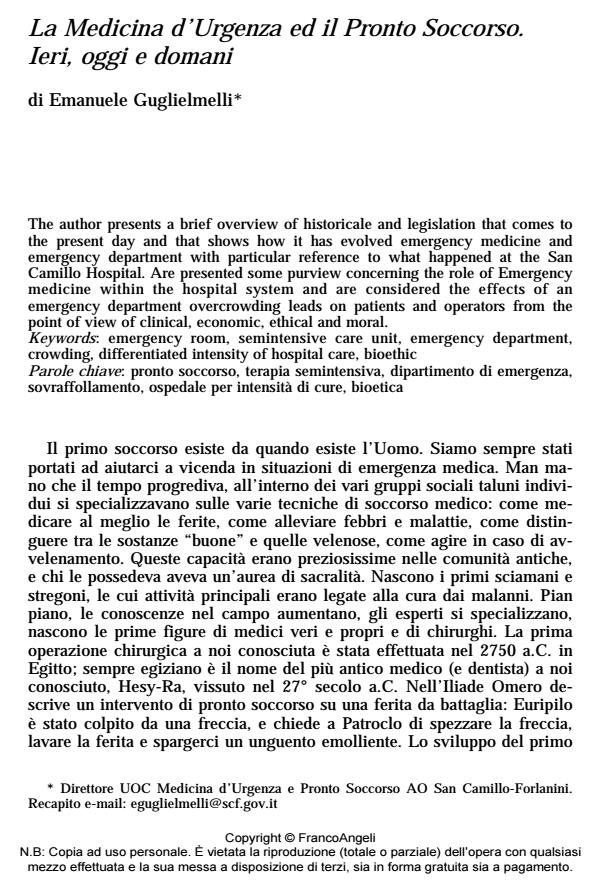La Medicina d’Urgenza ed il Pronto Soccorso. Ieri, oggi e domani
Titolo Rivista SALUTE E SOCIETÀ
Autori/Curatori Emanuele Guglielmelli
Anno di pubblicazione 2014 Fascicolo 2014/2
Lingua Italiano Numero pagine 16 P. 69-84 Dimensione file 502 KB
DOI 10.3280/SES2014-002007
Il DOI è il codice a barre della proprietà intellettuale: per saperne di più
clicca qui
Qui sotto puoi vedere in anteprima la prima pagina di questo articolo.
Se questo articolo ti interessa, lo puoi acquistare (e scaricare in formato pdf) seguendo le facili indicazioni per acquistare il download credit. Acquista Download Credits per scaricare questo Articolo in formato PDF

FrancoAngeli è membro della Publishers International Linking Association, Inc (PILA)associazione indipendente e non profit per facilitare (attraverso i servizi tecnologici implementati da CrossRef.org) l’accesso degli studiosi ai contenuti digitali nelle pubblicazioni professionali e scientifiche
The author presents a brief overview of historicale and legislation that comes to the present day and that shows how it has evolved emergency medicine and emergency department with particular reference to what happened at the San Camillo Hospital. Are presented some purview concerning the role of Emergency medicine within the hospital system and are considered the effects of an emergency department overcrowding leads on patients and operators from the point of view of clinical, economic, ethical and moral.;
Keywords:Pronto soccorso, terapia semintensiva, dipartimento di emergenza, sovraffollamento, ospedale per intensità di cure, bioetica
- American College of Emergency Physician (2006). Crowding. Ann Emerg Med, 47: 585
- American College of Emergency Physicians (2008). ACEP’s 40th Scientific Assembly. October 27-30 2008
- Asplin B.R. et al. (2003). A conceptual model of emergency department crowding. Ann Emerg Med, 42: 173-180
- Barret L. et al. (2012). A bed management strategy for overcrowding in the ED. Nurs Econ, 30(2): 82-85
- Beauchamp T.L. et al. (2001), Principles of Biomedical Ethics. 5th ed.. New York: Oxford University Press
- Berger E. (2013). Physician Burnout. Emergency Physicians See Triple Risk of Career Affliction. Ann Emerg Med, 61: 17-19
- Casazza F. et al. (2013). Prognostic significance of free-floating right heart thromboemboli in acute pulmonary embolism. PrePrint Online in “Thrombosis and haemostasis” on 2013-10-02
- Chatterjee P. et al. (2011). Emergency department crowding and time to care in patients with acute stroke. Stroke, 42: 1074-1080
- Exadaktylos A.K. et al. (2008). Strategic emergency department design: An approach to capacity planning in healthcare provision in overcrowded emergency rooms. J Trauma Manag & outcomes, 2(11): 1-8
- Garson C. et al. (2009). ED patient preferences for boarding locations when hospital are at full capacity. Ann Emerg Med, 51: 9-15
- Golini A. (2005). Trend dell’invecchiamento femminile. Atti del 81° Congresso SIGO - Bologna 20-24 settembre 2005
- Greene J. (2007). ED flow an the boarded patient: how to get admitted patients upstairs. Ann Emerg Med, 49: 68-70
- Guglielmelli E. et al. (2007). Retrospective of pulmonary embolism management in Emergency Department. Gazzetta Medica Italiana - Archivio Scienze Mediche, 166 (2): 69-74
- Guglielmelli E. et al. (2007). Emergency management of pulmonary embolism: retrospective analysis. 4th Mediterranean Emergency Medicine Congress (MEMC IV) Sorrento, settembre 2007
- Higginson I. (2012). Emergency Department crowding. Emerg Med J, 29(6): 437-43
- Hoot N. et al. (2008). Systematic review of ED crowding causes, effects, and solutions. Ann Emerg Med, 52: 126-136
- Howell E. et al. (2008). Active bed management by hospitalist and ED throughput. Ann Intern Med, 149: 804-810
- Institute of Medicine, Committee on the Future of Emergency Care in the United States Health System (2006). Hospital-Based Emergency Care:at the Breaking
- Point. National Accademy Press, Washington (DC), Executive summary available at: www.nap.edu/catolog/11621.html (ultimo accesso: 28 luglio 2013). Iserson K.V. et al. (2007). Triage in medicine, part I: concept, history and types. Ann Emerg Med, 49: 275-281
- Joint Commission Delays in treatment of sentinel event alert (2002). Issue 26 available at www.jointcommission.org/assets/1/18/SEA_26.pdf
- McCarthy M.L. et al. (2009). Crowding delays treatment and lengthens emergency department of stay, even among high-acuity patients. Ann Emerg Med: 54: 492-503
- McHugh M. et al. (2011). Improving Patient Flow and Reducing Emergency Department Crowding: A Guide for Hospitals. Agency for Healthcare and Quality October 2011- 11(12)-0094: 1-48
- Monaco G. et al. (2008). Non invasive ventilation (NIV) and acute respiratory failure (ARF) in Emergency Medicine Unit. 2th Mediterranean Meeting on Non
- Invasive Ventilation – Roma – 7-8 novembre 2008; Pag. 110. Abstract Moskop J.C. et al. (2009). ED crowding part 1 - Concept, causes, and moral consequences. Ann Emerg Med, 53: 605-611
- Moskop J.C. et al. (2005). From Hippocrates to HIPAA; privacy and confidentiality in emergency-medicine – Part I: conceptual and legal foundation. Ann Emerg Med, 45: 53-59
- Shanafelt T.D. et al. (2012). Burnout and satisfaction with work-lifebalance among US physicians relative to the general US population. Arch Intern Med, 172(18): 1377-1385
- Simchen E. et al. (2007). Survival of critically ill patients hospitalized in and out of intensive care. Crit Care Med, 35: 449-457
- Sun B.C. et al. (2013). Effect of ED crowding on outcomes of admitted patients. Ann Emerg Med, 61(6): 605-611
- Tsai C.L. et al. (2010). Quality of Care for Acute Myocardial Infarction in 58 U.S. Emergency Departments. Acad Emerg Med, 17(9): 940-950
- Viccellio A. et al. (2009). The association betwwen transfer of ED boarders to inpatients hallways and mortality: a 4 years experience. Ann Emerg Med, 54: 487-491
Emanuele Guglielmelli, La Medicina d’Urgenza ed il Pronto Soccorso. Ieri, oggi e domani in "SALUTE E SOCIETÀ" 2/2014, pp 69-84, DOI: 10.3280/SES2014-002007